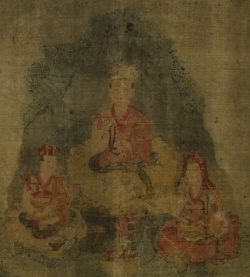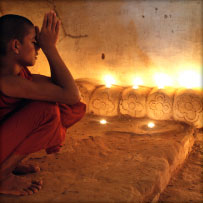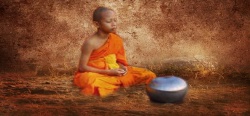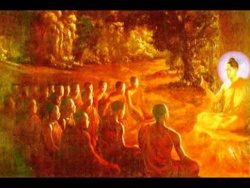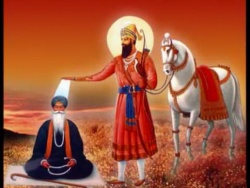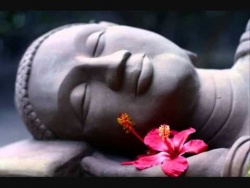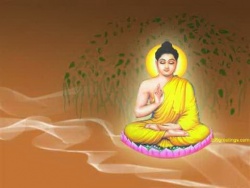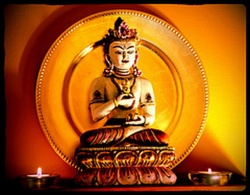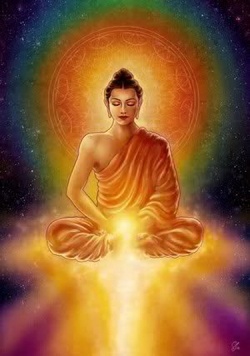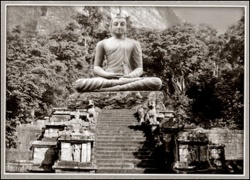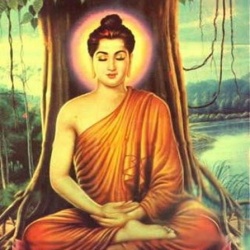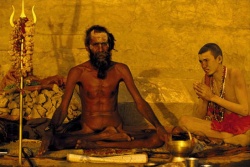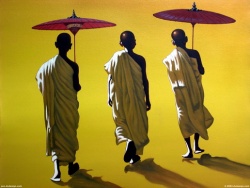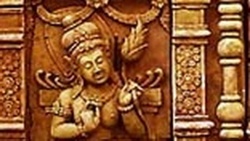The Tenth Karmapa, Choying Dorje
Choying Dorje (chos dbyings rdo rje) was born in 1604, on the twenty-eighth day of the third lunar month, in a village called Kizitang (ki zi thang) in the upper Mar (smar stod) valley in Golok (mgo log), on the border of Amdo and Kham. His father, Khyigu (khyi gu), was a member of the prestigious Bitsa (sbi tsha) clan. His mother, Amtso (a mtsho), belonged to the high-ranking Kyuruza (kyu ru bza') clan. His parents already had seven children: five daughters and two sons, who were named Namkha (nam mkha') and Abum (a 'bum). They gave him the name Orgyen Kyab (o rgyan skyabs).
Early Years: Under the Control of Chakmo Gushri
The parents' status brought the child to the attention of Sixth Zhamar, Chokyi Wangchuk (zhwa dmar 06 chos kyi dbang phyug, 1584-1630), who was searching for the reincarnation of his master, the Ninth Karmapa, Wangchuk Dorje (karma pa 09 dbang phyug rdo rje, 1601/1603). When rumors began to circulate that Orgyen Kyab was a candidate for the recognition, a local warlord named Chakmo Gushri (lcags mo gushri) on the northeastern edge of the Tibetan Plateau, who was an adherent to the Karma Kagyu tradition, apparently sent an agent to lure the boy and his family to his domain. Chakmo Gushri presented extensive gifts to Sengge (seng ge), the leader of Golok, who soon sold Orgyen Kyab's family to the warlord. Chakmo Gushri exerted considerable control over the young boy for the next decade.
The Zhamar was unable to convince Chakmo Gushri to give the boy to him for training, despite reminding him that it was Chakmo Gushri's forefathers who sent the Ninth Karmapa to the Fifth Zhamar, Konchok Yenlak (zhwa dmar 05 dkon mchog yan lag, 1525-1583). Forced to leave the child on the Mongolian frontier, the Zhamar sent for the Third Pawo, Tsuklak Gyatso (dpa' bo 03 gtsug lag rgya mtsho, 1567/8-1630), who had studied under the Fifth Zhamar, the Ninth Karmapa, and the Fourth Gyeltsab, Drakpa Dondrub (rgyal tshab 04 grags pa don grub, 1550-1617) to serve as his tutor. For three years, however, Chakmo Gushri prevented the Sixth Zhamar from meeting the boy.
In the ninth lunar month of 1611, the Karmapa learned to read and write by copying letters written by a Zhabdrung Shunpa (zhabs drung shun pa, d.u.) who must have had exemplary handwriting. Although age eight is quite late to start reading and writing, Orgyen Kyab soon became very good at both. Nine months later, in the sixth month of 1612, Orgyen Kyab composed his first poem during a visit to Mecho Jungteng (mas chos 'byung stengs), a meditation cave of the First Karmapa Dusum Khyenpa (P1400 karma pa 01 dus gsum mkhyen pa, 1110-1193) near Kaṁpo Nenang (kaM po gnas nang) Monastery, also known as Densa Wokma (gdan sa 'og ma), the monastery the First Karmapa had established in Litang in 1165.
The high peaks of the snow mountains lighten the darkness of the heart. The green grass plots are always charming. The lute of the river sounds its song, which rouses disgust for saṁsāra These are the excellent places for practicing the dharma.
In 1613, in addition to practicing writing and learning prayers, Orgyen Kyab meditated on the praises of the lives of the previous Karmapas. He also studied the life story of Milarepa (mi la ras pa, 1040 -1123), and developed a deep affection for this great Tibetan, his enthusiasm no doubt intensified by the difficulties that had surrounded him during the previous years.
In the second lunar month of that same year he made his first recorded drawing, recording a vision he had had in the evening. On a square piece of white cotton cloth he depicted the First Karmapa with matted hair, a black hat, and robe. In the fourth month of the same year he painted on paper a picture of a famous episode of Milarepa's life, his rescue of a deer from a hunter named Gonpo Dorje (dgon po rdo rje). Milarepa was depicted with a bright, radiant complexion surrounded by the hunter with his dog and a deer seated in the middle of clouds, with fog covering snow mountains in the background.
It is not certain whether these works resulted from his having received formal instruction or whether they were just the drawings of a precocious child. However, in early 1614 he spent his time studying both scriptures and all kinds of painting techniques.
In the late summer of that year news reached the Karmapa that the Fourth Tsurpu Gyeltsab had passed away at the age of sixty-seven. The incarnation line of the Gyeltsab, which means "regent", traditionally served as the representative of the Karmapas during the interregnum following the death of one Karmapa and the investiture of the next. With the passing away of Drakpa Dondrub, and with Orgyen Kyab still under the control of Chakmo, the seat of the Karma Kagyu tradition, Tsurpu Monastery (mtshur phu), was without a leader.
The situation must have worried Chakmo. Having previously refused any invitations from Tsurpu for the Karmapa to visit, he now made preparations to take the Orgyen Kyab and his family there. In the autumn of 1614, they departed on horseback.
First Journey to Tsurpu and Early Studies
Upon entering Tsurpu Monastery on the twenty-fourth day of the fifth month in the year 1615 the Karmapa expressed his wish to first visit the most highly venerated Buddha statue located in the rear of the assembly hall inside the Great Temple (lha chen khang). This was an enormous cast-bronze statue, about sixty-six feet tall, known as the Ornament of the World ('dzam bu gling gi brgyan); it was destroyed in 1960. After seeing the statue, he then went to the residence quarters in the Zhelre Lhakhang (zhal ras lha khang), on the roof of the Podrang Tsuklakhang temple (pho brang gtsug lag khang), where he stayed alone in retreat for one day. After that, he felt relaxed and expressed his happiness, saying to his servants, "By reaching here, I already feel rested. Do not whirl around too much in here! Don't spoil the residence quarters!"
On the eighth day of the sixth month of 1615, six weeks after the Karmapa had settled at the monastery, the Third Pawo, who had promised the Zhamar to take responsibility for his education, arrived at Tsurpu. This was the first meeting between Orgyen Kyab and Tsuklak Gyatso. After the Pawo had rested for about a month, Orgyen Kyab went before his teacher and prostrated one hundred times. Having finished this gesture of respect, he folded his hands, bowed down, and asked the Pawo to bestow teachings and to perform the tonsure ceremony of initial ordination.
Accordingly, on the thirteenth day of the seventh lunar month of the year 1615, Tsuklak Gyatso cut a lock of the Karmapa's hair in front of a wooden Buddha statue called Jowo Ghandhola (jo bo ghandhola), said to have been carved by Nāgārjuna from wood of the Bodhi Tree at Bodh Gaya. The Pawo gave him the ordination name Choying Dorje, the long form of which was Pelden Jikten Sumgyi Drenpa Kuzhi Lhundrub Choying Kunto Khyabpai Trinle Takpai Dorje Gyurwa Mepa Yizhingyi Nyingpo Gyepa Zamepa Ngonpar Towai Pel (dpal ldan 'jig rten gsum gyi 'dren pa sku bzhi lhun grub chos dbyings kun tu khyab pa'i 'phrin las rtag pa'i rdo rje 'gyur ba med pa yid bzhin gyi snying po rgyas pa zla med pa mngon par mtho ba'i dpal).
The following years were filled with intensive daily studies. The Pawo instructed the Karmapa in various Buddhist scriptures from the Kangyur and Tengyur, including the Avataṁsaka, Ratnakūṭa, Vinaya, Prajñāpāramitā, and various other sutras and tantras, as well as the life stories of saints, religious histories, poetics, and the collected writings of former Karmapas, Zhamars, and other masters. When the Pawo started teaching the Karmapa calligraphy, the Karmapa said to him, "Even though I played around as much as I wished, you, the Zhabdrung (zhabs drung), remained pleased. We will get on together very well." Obviously, the Pawo was sympathetic to the age and personality of his student. The Karmapa, in return, loved his teacher and studied hard.
On the twenty-eighth day of the ninth lunar month of the year 1615, the Tsang Desi, then the ruler of most of U and Tsang, Karma Puntsok Namgyel (sde srid karma phun tshogs rnam rgyal, 1550-c.1621) invited the Karmapa to visit him in Yarlung (yar rgyab/yar lung) and Dakpo (dwags po) in southern U. Previously the Chakmo, who was still present in the Karmapa's entourage, forbade him from accepting any invitation from the Tsang king. But this time he answered positively.
On his way to Shigatse, on the nineteenth day of the third lunar month of the year 1616, when approaching Panam (pa snam) southeast of Shigatse, the Karmapa was received with a luxurious banquet, monks on horseback, and a procession of a large number of monks. He proceeded to the Lhundrubtse (lhun grub rtse) fortress in Panam, where he stayed in the residential quarters of the Lukhang (klu khang). There he spent most of his time with the Pawo, who gave him the reading transmission for the collected writings of the Ninth Karmapa, Marpa Chokyi Lodro (mar pa chos kyi blo gros, c.1012-1097), Milarepa, Gampopa Sonam Rinchen (sgam po pa bsod nam rin chen, 1079-1153), the Fifth Zhamar and the Second Pawo, Tsuklak Trengwa (dpa' bo 02 gtsug lag phreng ba; 1504-1566).
During this period of intensive learning, the Karmapa also made paintings of numerous ḍākinī. His art teacher at the time, working in the old Menri (sman ris) style, was the great artist Tsering (tshe ring) from Lhodrak Chukhyer (lho 'brag chu 'khyer).
On the ninth day of the tenth lunar month of the year 1616, the Karmapa left Panam and proceeded to Bum Tangang (bum stang sgang), close to Shigatse, where the king of Tsang had pitched a tent for a banquet and constructed a throne to welcome the Karmapa. On the auspicious tenth day, the ruler hosted a huge reception, comparable to the unimaginably sumptuous reception of the Fifth Karmapa Dezhin Shekpa (karma pa 05 de bzhin gshegs pa, 1384-1415) by the Ming Yongle Emperor (永樂, r.1402-1424). The Karmapa was guided to the tent by five hundred of the ruler's attendants, all dressed in beautiful Chinese costumes and wearing precious jewelry. One hundred musicians played flutes, conch shell horns, thigh-bone trumpets, and all sorts of drums. Many soldiers carried, as a demonstration of the ruler's power, battleaxes (dgra sta), pikes (rtse gcig), spears (mdung), hatchets (sta gri), hooks (lcags kyu), clubs (dbyugs to), and other weapons.
As soon as the Karmapa was seated on the throne in the banquet tent, the king of Tsang, followed by his officials, offered him a greeting scarf and received blessings from the lama's hand. When the festivity was over, the Karmapa was accompanied to Samdrubtse (bsam grub rtse) Fort in Shigatse by several thousand people. He stayed there only briefly before returning to Panam, where, after the New Year of 1617 he studied intensively for several months. In the same year, Khyigu's breaking the rule forbidding the consumption of alcohol in the encampment was used as a pretext by Chakmo Gushri to slander the Karmapa's father, his mother, and two brothers to the king of Tsang, who ordered the Karmapa's family to be ejected from the camp.
The Pawo saw his opportunity to carry out the promise he had made to the Karmapa in 1615, to show him Milarepa's tower. They left Panam and traveled on horseback southeast to Lhodrak. On the thirteenth day of the eleventh month of the year 1618 the Karmapa together with his encampment proceeded to Neudong (sne'u gdong), the capital of the Pakmodrupa (phag mo gru pa) rulers of Tibet in the fourteenth and fifteenth centuries, at the extreme south of Tsetang (rtsed thang) on the southern bank of the Tsangpo River. There he went to the huge palace of Neudongtse, where he was formally received by the Sakyong Tripa (sa skyong khri pa), the Neudong ruler and his relatives, officials, and ministers, all wearing precious jewel ornaments, together with a line of monks who waited in his honor.
The Zhamar, who had since 1611 been traveling to various distant countries such as Mongolia and Jang ('jang), came to meet the Karmapa at Neudong. The moment the Karmapa saw the Zhamar coming, he made prostrations. The Zhamar reciprocated the expression of respect by offering prostrations in return. He gave the Karmapa an Avalokiteśvara painting, with the following words: "Make this, whose mere sight is meaningful, your main deity. It is appropriate to make him various kinds of offerings from time to time." The Karmapa for his part bestowed upon the Zhamar a silk-embroidered image of the Buddha.
The power over the Karmapa of Chakmo Gushri came to an end in 1620, with the intervention of the king of Tsang. In all probability Chakmo died in prison. This same year the Karmapa's banished family was allowed to return to the Karmapa's entourage.
In 1621 fighting broke out again between the Mongols and the king of Tsang, who now planned to conquer the whole of U. The Sixth Zhamar, at the request of the Karmapa, tried to stop the king from waging war, but was unsuccessful. In the end, the Tsang army was encircled by the Mongol army on Chakpori (lcags po ri) hill of Lhasa. The Fourth Paṇchen Lama, Lobzang Chokyi Gyeltsen (paN chen bla ma 04 blo bzang chos kyi rgyal mtshan, 1569-1662) intervened and saved the lives of many soldiers. In return, the king of Tsang had to give back most of the territories in U that he had conquered. During the last battle he received the bad news that his wife had died at home of a severe illness, probably of smallpox. The king himself succumbed to the disease on his return to Tsang. His fifteen year old son, Karma Tenkyong Wangpo (karma bstan skyong dbang po, 1606-1642), was placed on the throne of Samdrubtse.
The next encounter between the Karmapa and the Zhamar happened at a place the name of which is recorded as Tromsa (khrom sa). From there, the Karmapa journeyed on horseback in the company of the Pawo and the Zhamar, to Drowolung Sekhar Gutok (gro bo lung sras mkhar dgu thog), also known as Lhodrolung (lhodrolung) Monastery, which he had visited before in 1617. Lhodrolung was then the seat of the Pawo incarnations.
During the time at Lhodrolung, the Karmapa continued his studies with the Pawo, who read to him, among other texts, the collected works of the Second Zhamar Khacho Wangpo (zhwa dmar 02 mkha' spyod dbang po, 1350-1405). Over the next three years, from 1622 to about 1625, he studied painting extensively, and expressed in his autobiography that it was then that he felt he mastered the art.
Ordination at Tsurpu
When autumn approached, the Karmapa returned to Tsurpu to attend to obligations there. He had been absent from this, his main seat, for about eight years. Gradually, the other three highest Karma Kagyu lamas -- the Pawo, Zhamar, and the Fifth Situ, (si tu 05 chos kyi rgyal mtshan, 1562-1632) -- returned to Tsurpu and joined the Karmapa. In 1624, when the Karmapa was twenty-one, they presided over his ordination ceremony.
Fourteen years had passed since the Zhamar had come to Chakmo to recognize Orgyen Kyab as the Tenth Karmapa, and during this time the brilliant scholar had had little chance to pass on his knowledge to his main disciple and successor. In 1625 they finally sat down together for intensive studies, and a close and affectionate relationship developed between them. The two of them even passed time swimming in the river and laying on the grass gazing at stars.
During these years the Karmapa produced a great number of works of art. At Yerpa (yer pa), to mention only one example, he painted a copy of the famous eleventh-century set of Chinese-style depictions of the Sixteen Elders known as the Yerpa Rabama, basing it not on the original, but on the earlier copy by the famous painter Jeu (bye'u), who lived in the fifteenth century. At about this time, the Karmapa also started giving his first teachings, explaining the Four Dharmas of Gampopa and the guruyoga.
The Zhamar having assumed his traditional role as the main tutor, in 1627 the Third Pawo returned to Lhodrak. The Karmapa visited him there once in order to bring to completion the initiations and reading transmission for the texts they had begun together. This was the last time they saw each other, as the Third Pawo passed away in 1630.
In late 1628 the Zhamar received a message from the king of Tsang, Karma Tenkyong Wangpo, inviting him, the Karmapa and his retinue to a park near Shigatse. They stayed through the winter, and when spring of 1629 approached, they left to visit places associated with Milarepa, such as Drin (brin) and Nyenam (snye nam). They first traveled to the monastery of Nartang. There, in the assembly hall, the Karmapa copied a huge painting by the great master Mentangpa Menla Dondrub (sman thang pa sman bla don grub, d.u.) of a Ācala.
At Drin, the Zhamar built a hermitage and a temple, and the king of Tsang gave the entire site to him to create a new monastic community. According to tradition, during the sanctification rituals (sa chog) both the Zhamar and the Karmpapa carried stones and soil on their backs for the construction. Soon after the temple was completed the Zhamar requested the Karmapa to paint an image of the Sixteen Arhats. Five months later he presented his teacher with the completed work.
Pilgrimage to Kailash and Tsari
In the autumn of 1629 the Karmapa received permission from his teacher to go on pilgrimage to Mt. Kailash. The Zhamar advised the Karmapa to take good care of himself and to beware of bandits who haunted the deserted plains. The Karmapa performed this pilgrimage from Dingma Drin (ding ma brin) to Lake Manasarovar on foot, without, it is said, even an umbrella to protect him from the hot sun. On his return he passed through Kyirong (skyid grong) on the Tibet-Nepal border, a valley that contains numerous important Milarepa sites, as well as the temple of the Pakpa Wati ('phags pa wa ti), a seventh-century sandalwood statue, which he sketched. There Karmapa stayed for some time in the meditation Zaok Puk (za 'og phug) cave of Tilopa, where he made a painting of Milarepa. During his stay in Kyirong, the Karmapa was offered rice, yoghurt, milk, and sugarcane every day by the hunters of Mangyul.
The Karmapa then went to Dingri (ding ri), where he was received by a group of about five hundred followers, who were also astonished to see that instead of riding a fine horse, the highest dignitary of the Karma Kagyu tradition was traveling on foot without so much as an umbrella. Keeping only five servants, he seemed almost naked without his traditional entourage of seven hundred attendants. The Karmapa explained:
Though the king has indeed made good offerings, I do not place confidence in him, for the following reasons: Since the glory and the goods of the king are unstable and illusory, which wise person would consider his offerings and respect to be real? Love and desire for honor [lead to] recklessness. Such recklessness causes moral faults. All suffering arises as the karmic result of faults. This is Dependent Origination.
While still at Dingma Drin, the Karmapa worked a great deal on his art. He passed his time painting a Buddha, the Sixteen Arhats, and Avalokiteśvara. He also made preparations for the Zhamar's arrival at the hermitage at Dingri, which the Zhamar had built before embarking on a trip to Nepal. He had erected a throne protected by a canopy and umbrella, arranged fine robes, golden vessels filled with incense of white sandalwood, aloe-wood (a ga ru) and all kinds of offerings, food and drinks. When, after seven days of preparation, the Karmapa was told that the Zhamar would arrive the next day, he got up early in the morning, washed himself, put on new garments, and waited to give his tutor a great welcome at Trode Tashi Shigang (spro bde bkra shis sgang), a boulder that marked the spot were Gampopa had met his master Milarepa for the first time.
During their stay at Dingri the Zhamar fell ill, and the Karmapa nursed his master day and night. He helped him to properly rearrange his robes when they became twisted, brought him water to rinse his mouth, burned incense for him, and brought his bed pan when needed. Then he would serve the Zhamar yoghurt and milk. While the Karmapa was devotedly nursing his sick master, a monk arrived from Lhodrak bearing the sad news of the sudden death of his former teacher, the Third Pawo. In order not to worsen the Zhamar's condition, the Karmapa kept the death of the Pawo secret.
One morning at daybreak, when the Karmapa asked his master how he had spent the night, the master answered happily that he had spent it without any pain and that his body was rested. The Karmapa offered him a cup of excellent tea, which he drank as his last beverage in order to fulfill his student's wish. Not long after sunrise, the Zhamar passed away.
The Karmapa spent the next few days playing the lute, reflecting on the loss of his beloved teacher. According to the biography written by the Karmapa's disciple and close attendant Tsang Khenchen, Pelden Gyatso (gtsang mkhan chen dpal ldan rgya mtsho, 1610-1684), whom he called "Kuntu Zangpo (kun tu bzang po), his playing inspired several acts of extreme devotion. Thirty-five monks engaged in what is generally considered a Chinese Buddhist offering practice, the burning of a finger. After binding a finger tightly to cut off circulation, they wrapped it in cloth and soaked it in butter and set it on fire, letting it burn down to the bone. One monk named Yangdak (yang dag) went so far as to self-immolate, burning his entire body in sacrifice.
Soon thereafter, the Karmapa set off on the long journey northeast, accompanying the Zhamar's mortal remains to Tsurpu. There he supervised the construction of a seven-story silver reliquary on which artisans from Nepal spent three years building. He consecrated it with gold coins and butter lamps arranged in the shape of victory parasols and rosaries. The ground in front of the reliquary was covered with flowers and incense vessels. The Karmapa made a painting of the Sixteen Arhats and made statues of Hayagrīva, Mañjuśrī, Avalokiteśvara, and Vajrapāṇi. The temple around the reliquary was named Rabten Podrang (rab brtan pho brang); as an act of devotion, the Karmapa carried rocks and soil during its construction, and he crafted the golden relief of the ringed-doorknocker and the solid floor covering (sa lcags).
The Karmapa is reported to have spent the years after the death of his teachers in strict solitude. His entourage also adopted that attitude of "mental renunciation" (yid byung) and cultivated an attitude of disgust with all the concerns of this life.
Early in 1636 the Karmapa left Tsurpu and set off on another pilgrimage, this time to Tsari (rsa ri tra), a mountain on the Tibetan-Indian border that had been a major destination for Kagyu pilgrimage since Milarepa. On the way he stopped at various monasteries to view and copy art. At Daklha Gampo (dwags lha sgam po), the famous Kagyu monastery founded in the twelfth century by Gampopa, he made a painting illustrating a vision he had of Gampopa riding a lion and surrounded by a group of Indian ācārya.
At Tsari he visited the important monastic sites, mountains, caves, and lakes. At Ganden Mamo (dga' ldan ma mo), one of the monasteries of Tsari founded by the Second Zhamar in 1386 as a hermitage, he celebrated the New Year of 1637. While there, he made a drawing for embroidered images of the Sixteen Arhats surrounded by sixteen-thousand four hundred arhats and set up a workshop with ten craftsmen. At Nakpu (nags phu), a retreat founded by the Third Karmapa, Rangjung Dorje (karma pa 03 rang byung rdo rje, 1284-1339), he took an image of the Sixteen Arhats, which had been painted during the Yuan Dynasty. Via Druk Choding ('brug chos sding) he went to Purchu (phur chu), where he made a drawing of a statue of Avalokiteśvara. The Karmapa made a second painting of the same deity for his disciple Tsele Naktsok Rangdrol (rtse le sna tshogs rang grol, b. 1608), who had come to visit him. Other places he visited included Nekok Treng (gnas lkog phreng) Temple, sanctified by the Third Karmapa, and two meditation caves of Padmasambhava: Timdrak (thim brag) and Sengdam (seng 'dam).
The Karmapa stayed on the Zhomang (zho mang) plain below Tsari for some time. Finally, before returning to Tsurpu, he again visited Lhodrolung in Lhodrak. There, several people, including the Nyingma lama Dhitsa Tulku Jikten Wangchuk (dhi tsha sprul sku 'jig rten dbang phyug, d.u.) presented him with a variety of impressive and unusual animals, which he is said to have never sold or locked in cages, instead allowing them to roam around freely. The Karmapa asked the Dhitsa Tulku to compose some prayers for Avalokiteśvara, which he did. Pleased, in return the Karmapa presented the Dhitsa Tulku many different types of material objects as well as a painting showing the Dhitsa Tulku sitting in the posture of Maitreya on an elephant.
Returning to Tsurpu, the Karmapa stopped over in Lhasa to worship at the temples there. He stayed at the Kyarbo (skyar bo) estate, and there his eldest brother, Namkha, who was either based in Lhasa or joined his brother on the road, suddenly passed away. The Karmapa invited the Fifth Tsurpu Gyeltsab, Drakpa Chokyang (mtshur phu rgyal tshab 05 grags pa mchog dbyangs, 1617-1658) to come and perform the funeral rites. He himself painted an image of the Sixteen Arhats as a memorial for his brother. His other brother, Abum, passed away soon after. The Karmpa painted an image of the five buddha families.
The Fifth Dalai Lama, Ngawang Lobzang Gyatso (tA la'i bla ma 05 ngag dbang blo bzang rgya mtsho, 1617-1682), reported Namkha's death in his own autobiography, in which he also recorded that the Karmapa was "behaving like an unconventional yogi." The phrase might suggest that the Karmapa was not observing his monastic vows, and was drinking and having intercourse with women. However there is nothing in the historical record to support this, and it is perhaps more likely that the Dalai Lama was referring to the Karmapa's penchant for wearing the brown and gray robes of a Chinese monk, and walking on pilgrimage without a suitable retinue.
Soon after the death of his brothers, U and Tsang again erupted into war, one that resulted in the total destruction of the kingdom of Tsang and the ascendance of the Dalai Lama and Geluk power in Lhasa. In 1639, at the invitation of Geluk hierarchs, the leader of the Khoshot Mongols Gushri Khan (1582-1655) led an army into Kham, obliterating the Bon kingdom of Beri (be ri) and then proceeded to march eastwards towards Lhasa. When Gushri Khan reached as far west as Kongpo and seized territories there, the Karmapa was asked by patrons and supporters to call up the considerable military forces of the area. He refused to get involved, saying, that should he be responsible for the destruction of the Geluk monasteries, "It would be an ugly thing for the Buddha's teachings." The Karmapa was later criticized for not helping to defend his patron, the king of Tsang.
In 1642 the Karmapa escaped the chaos of the fighting by going south to Lhodrak, where he took the opportunity to recognize the Fourth Pawo, Tsuklak Kuntu Zangpo (dpa' bo 04 gtsug lag kun tu bzang po, 1633-1649), who was then about eight years old.
Together with his disciples, the twenty-five-year-old Fifth Tsurpu Gyeltsab, Tsang Khenchen, and most probably the Fourth Pawo, the Karmapa stayed at a cave called the Marme Puk (mar me phug) of Nyanya (gnya' gnya'), which he had visited in 1617 with his late tutor, the Third Pawo. He spent most of this visit producing statues and paintings. He also received teachings from Tsang Khenchen. On the eighth day of the first month of the year 1643 at Sung Puk (zungs phug), the Karmapa performed the full monastic-ordination ceremony for the Fifth Gyeltsab and installed him in his office. On that occasion, the Fourth Pawo received also his novice ordination.
Meanwhile, after a long siege, Shigatse, the capital of the king of Tsang, finally fell to Gushri Khan's troops. The king was imprisoned in Lhasa and was executed there some months later. The young Fifth Dalai Lama was brought to Shigatse and entrusted with responsibility for religious affairs of Tibet, while Gushri proclaimed himself to be the king of all Tibet. Gushri and his Geluk supporters then embarked on a vicious campaign of destruction, razing monasteries belonging to the Nyingma and Kagyu tradition, converting many to the Geluk tradition.
The Karmapa attempted to negotiate with the Fifth Dalai Lama to have his monasteries restored to him, but for the most part the Dalai Lama refused, agreeing only to place his seal on a document that gave vague assurances to the protected status of the Karma Kagyu tradition. A supporter of the Karmapa with the title of Zhokhapa (zho kha pa) attacked the Geluk monastery Chokhorgyel Metoktang (chos 'khor rgyal me tog thang). Other rebels who launched attacks against the Mongolian invaders appear to have stayed at the Karmapa's encampment in Lhodrak. Consequently, in 1644, Gushri Khan's troops, supported by the Kyisho Depa, Choje Tendzin Lobzang Gyatso (skyid shod sde pa chos rje bstan 'dzin blo bzang rgya mtsho, 1593-1638), surrounded the encampment.
The twentieth abbot of Taklung Monastery (stag lung), Ngawang Tashi Peldrub (ngag dbang bkra shis dpal grub, 1600-1671) was asked to act as mediator. The Fifth Dalai Lama sent a letter to the Karmapa through the Taklung abbot, who went to the Karmapa with a Mongolian army at his command. A meeting between all of the concerned parties took place on the tenth day of the sixth month in the year 1644 at a place called Dorkha Pangshang (dor kha spang bshang). The Karmapa was asked to take an oath that he would not subvert the interests of the Geluk tradition. The Karmapa refused, stating that "This is not necessary. I should rather take the oath that earlier I did nothing to subvert the interests of either the Karma Kagyu or the Geluk Schools." This answer was taken as evidence that the Karmapa did not intend to cooperate.
The situation at the Karmapa's encampment grew graver with each passing day. When the Mongols finally attacked, at the end of 1644, the Karmapa himself managed to miraculously slip away on foot unscathed, accompanied only by his attendant, the Tsang Khenchen The encampment was completely destroyed and most of the monks ran away. Some were wounded, while some others were caught and killed.
Exile to Gyeltang
On the thirteenth day of the first month of the Tibetan New Year 1645 the Karmapa and his attendant fled to Mentang Shuktser (sman thang bzhugs 'tsher) in northern Lhodrak, where they stayed for seven days. During this short stay, the Karmapa made for his loyal attendant a statue of Vajrapāṇi from a mixture of herbs and clay. There, the local people offered them all the daily necessities as well as horses and pack animals. They then left for Tsari where they stayed for four months, during which time the Karmapa again found occasions to create art. He produced a Hayagrīva statue of medicinal herbs and clay and carved a Tārā from rhinoceros horn, which he presented to the Tsang Khenchen.
On the tenth day of the fourth lunar month of the same year, the Karmapa received word of the identification of his root lama, the Sixth Zhamar. The Seventh Zhamar, Yeshe Nyingpo (zhwa dmar 07 ye shes snying po, 1631-1694), had been born over ten years earlier in Marto. He immediately sent two monks, Rabjampa Karma Nyingje (rab byams pa karma snying rje, d.u.) and Drubpa Karma Dondrub (sgrub pa karma don 'grub), to offer the boy a long-life prayer, a white-felt carpet, a protection cord, and a rosary. To the boy's parents he sent a letter and gold coins. History is silent as to why the Karmapa had not himself earlier located the boy.
At the ferry crossing of Pongzira (spong dzi ra), the Karmapa was welcomed by Karma Tobden (karma stobs ldan), minister of the king of Jang Satam ('jang sa tham), who had brought with him about one hundred officials and servants. The large entourage accompanied the Karmapa to Gyeltang (rgyal thang) in southern Khams, where they arrived in late 1647. Jang Satam had been a supporter of the Karma Kagyu tradition since a visit there in 1515 of the Eight Karmapa, Mikyo Dorje (karma pa 08 mi bskyod rdo rje, 1507-1554), and was then providing a refuge for lamas fleeing the persecution in U and Tsang.
In 1648 the Karmapa spent the summer rainy season with the Tsang Khenpo in retreat at the Ketsego (ke tshe mgo) fort at Gyeltang. There he completed a painting of the Sixteen Arhats, which he presented to his disciple. Together they proceeded to the solitary Yang plain, where, on the fifteenth day of the eleventh lunar month the Karmapa finished his autobiography, the Wish-Fulfilling Cow at a solitary walnut-tree grove in a park north of a river on the bank of Gyeltang's Milk Lake ('o ma'i mtsho). He described this place as, "an area where [the people) speak two languages." He handed the text over to his disciple, asking him to preserve it with respect. At Gangkar Chesum (gangs dkar mched gsum) in southeastern Minyak, the Karmapa built a temple dedicated to Avalokiteśvara. For this new temple, he made painted thangkas depicting Cittaviśrāmaṇa Avalokiteśvara, Padmasambhava, the previous Karmapa and Zhamar incarnations, Mañjughoṣa, and Guhyapati.
At the end of the summer the Karmapa decided that he would travel north, without a retinue, to meet the Seventh Zhamar. Tsang Khenchen wept and expressed his worries about the dangers of such a journey, urging to be allowed to continue to accompany him. But the Karmapa held firm. He exchanged his monastic robes for common clothes, and set off alone on a horse. He concealed his identity from the people he met, relying on villagers for food and shelter. He was robbed by bandits of his possessions and horse, and had to continue on in rags and on foot, reduced to begging in a region where he could not even understand the local dialect.
It was during this period of exile and hardship that the Karmapa composed one of his best-known works, the Twelve Deeds of the Buddha. It seems that he met a Sakya hermit who offered him fine presents and served him for many days. Together they went to a Sakya monastery where the Karmapa was shown respect by the resident lama. There he read the Lalitavistara Sutra and then sat down to compose his verse narrative of the life of the Buddha.
Continuing on he came to a place called Boyul ('bo yul) in Minyak, on the border of Kham and China, near Dartsedo. There his identity came to be known. An old monk who had been in retreat for a long time recognized the Karmapa and addressed him with tears, "Earlier, when the Bodhisattva Chokyi Wangchuk [Sixth Zhamar) was wandering in U Province and preaching to the people at the side of the Yarlung Tsangpo River, you had not long since become a fully ordained monk and his servant. I saw you at the side of the Zhamar, in the middle of seven hundred monks, fanning him. What reasons do you see for now being satisfied with only these ragged clothes and staying here at this border region, like a solitary rhinoceros?"
Soon the local people were circumambulating him and preparing to welcome him in accordance to his high status. They brought offerings and set him up in comfortable quarters. The Karmapa gave them Buddhist teachings in return. He sat on a hip-high, round boulder as his religious throne and talked to the people about a variety of topics. He told them that saṁsāra was without substance, and that possessions fall away as easily as a water drop from the tip of a blade of grass. The body resembles water bubbles, which will inevitably be destroyed in the end. Life is like a butter lamp in the wind, near to extinction.
The Karmapa took the opportunity to send a letter and a religious object to Kuntu Zangpo via a tea trader, reporting the events of his journey, and he set off again, this time without concealing his identity. On his way he met some nomads who dismounted in haste, came near to him, and offered him milk and yoghurt. When they found out that he, a great lama, was going on foot, they presented horses to him. Around this same time the family of the Seventh Zhamar learned of the Karmapa's coming arrival, and they sent a relative welcome him.
Meeting the Seventh Zhamar
He passed through Targu (star gu), crossed the Dochu (rdo chu) river, and finally arrived at Mount Jowa ('jo ba ri), where he built a small temple and a large maṇi wheel. Near the Mar (smar) River, at a place called Dzepa (mdzes pa), he and the Seventh Zhamar, then seven years old, met. The Karmapa circumambulated the child three times and prostrated himself. The boy welcomed the Karmapa with a smile. Together they proceeded to the Seventh Shamar's town, located on the banks of the Mar River. Day after day, various groups of people arrived and prostrated themselves before the Karmapa. To the lama, who loved solitude, the coming and going of the numerous visitors who had come to see him and pay respects resembled a crowded marketplace in Kashmir. To make the young Zhamar happy, every day the Karmapa presented him with gifts. He gave new clothing to each of the boy's playmates and food and drink to the village people, delighting them all. The Karmapa also gave his new disciple a religious discourse on the need to first tame one's own mind, if one intends to tame the minds of others, a special point of bodhisattva practice. He also conversed with the young Zhamar about the places where the desirable objects of the world came from, about the ocean, and about the value of the various precious objects.
After some time, the Karmapa informed the Zhamar, "Earlier, I prostrated myself before the Bodhisattva Chokyi Wangchuk [the Sixth Zhamar). I respected and served him. And now I have served you, in the form of a child, here at this place in the same way. But now I will go because I would like to go visit my own country and I want to stay in solitude.” Yeshe Nyingpo replied that he also wanted to go see the villages and hamlets of the Karmapa's homeland. And so the Karmapa, the Zhamar, and various groups of people traveled together to upper Golok.
Early one morning, the Karmapa reached the meadow next to the hill at the river's edge where his house, beautified by skylights, had once stood on a spot higher than the other houses of the hamlet. It had been destroyed, and in its place there now stood a small temple housing a mural of the thirty-five buddhas and a collection of sacred scriptures of the Buddha. He spent that night in the grove with blue utpala flowers. The next morning he decorated one of his best horses with a bridle and saddle with various designs in silver and gold. Then he called the Zhamar to the temple, where he presented him with the horse. The boy mounted and rode home.
At around this time, the ever-faithful Tsang Khenchen, Kuntu Zangpo set off from Gyeltang with a large number of hundred companions to meet his master. As he was approaching Mar, Kuntu Zangpo sent a messenger on a fast horse to inform the Karmapa, who was overjoyed that his companion would soon return to him. He set out the same day on horseback to welcome his servant. When they met the two prostrated to each other, exchanged gifts, and sat together for long conversations.
To celebrate the New Year of 1651 the Karmapa took up again, after a break of two years, his artistic work, making a painting of Vajradāraṇa. That year the Karmapa identified the reincarnation of the Fourth Pawo, who had died two years earlier at the age of just sixteen. The Karmapa encountered the child at a meditation site at the foot of Mount Dorje Gyudron (rdo rje gyu sgron), when the boy reached out and took hold of the Karmapa's robe.
Return to Gyeltang
The Karmapa, Tsang Khenchen, and their companions returned to Gyeltang. The group traveled to Mangnyen (mang nyan), where, in the monastery of Gangkar Chode (gangs dkar chos sde), in Bo Gangkar ('bo gangs dkar), the Karmapa painted from memory an image known as Draktokma (brag thog ma): a Buddha surrounded by the Sixteen Arhats. The Karmapa presented this painting to the Pakmo Zhabdrung Rinchen Choga (phag mo zhabs drung rin chen mchog dga'). For Kuntu Sangpo he carved a figure of Tārā from white sandalwood, and for the year-end rituals of 1651 he made a painting of Vajrapāṇi.
From Bo Gangkar in Minyak, where they observed the Great Prayer festival for the New Year of 1652 the Karmapa and Tsang Khenchen proceeded to Yanglhung (g.yang lhung). There the Karmapa again showed his gratitude to his servant by formally enthroning him, having him sit next to him, and allowing him to sit on one-half of his carpet. He gave him a seal made from agate and more than ten thousand offerings (khri rwa can gyi 'bul ba) including a silk figure of Tārā, a statue of Tārā he had carved from sandalwood, and a painting of the Sixteen Arhats At the request of Tsang Khenchen, the Karmapa painted the "secret body" of the (rgyal ba'i gsang sku) with earrings and matted locks tied into a knot on top of its head.
In 1652 the Seventh Zhamar arrived from Golok and met the Karmapa at Pel Lhakhang (dpal lha khang). Together they visited a famous speaking statue of the Second Karmapa, Karma Pakshi (karmapa 02 karma pakshi, 1204-1283), located in Sengge Monastery. Then they went back to Yanglhung, where, on the first day of the ninth lunar month of the year the the Karmapa gave Zhamar novice ordination, with Tsang Khenchen acting as assistant preceptor and Ngari Rabjampa Karma Zabsel (mnga' ris rab 'byams pa karma zab gsal) acting as mentor. The Karmapa gave his disciple the name Zhiwa Drayangkyi Gyelpo (zhi ba sgra dbyangs kyi rgyal po).
Endless streams of visitors came to see the Karmapa and his disciple at this time. Shortly after the full moon of the fourth lunar month the Karmapa made a painting of the Twelve Deeds of the Buddha. Then he gave to the Zhamar ink and paper and bade him do a sketch of the painting of the Sixteen Elders known as Draktokma. The Zhamar stayed with his master for about one year, during which he received various teachings. Then he returned home to Mar in 1653, and the Karmapa went back to Gyeltang.
After the New Year feast of 1654, the Karmapa proceeded to Gorapar (sgo ra spar), where he once again started a painting of the Twelve Deeds of the Buddha. That year, the Sixth Situ, Chogyel Mipam Trinle Rabten (si tu 06 chos rgyal mi pham 'phrin las rab brtan, c.1640-1682) incarnation arrived with his tutors and other students (dpon slob). For one of his students, the Zhagom Kukye Karma Kelzang Nyingpo (zhwa sgom sku skye karma skal bzang snying po), the Karmapa created a set of five paintings depicting the Sixteen Arhats, and for Tsang Khenchen he made a painting of a local deity.
This group of lamas then all traveled together to Shayul (sha yul), where one year later, in 1655, they gave full ordination to Situ. The Karmapa gave him the name Chogyel Trinle Rabten Drola Gyepai Pal (chos rgyal phrin las rab brtan 'gro la dgyes pa'i dpal) and presented him paintings he had made in the elegant archaic style of the master painter Jiu (chi'u, early fifteenth century).
In 1657, as an act of deep devotion, Tsang Khenchen made two small golden stupa, spending one hundred measures of gold on each to enshrine two of the Karmapa's teeth. He also commissioned one silver stupa to enshrine the Karmapa's hair gathered after a single trim. He also spent more than one hundred measures of gold to build a "residence" (bzhugs khang) for two Tārā statues crafted by the Karmapa. The first was carved of white sandalwood and the second was a statue formed either of pieces of silk soaked in glue or carved from the wood of the Siu (si'u) tree.
In 1658 learned that the Fifth Tsurpu Gyeltsab had passed away at Tsurpu. The Karmapa, who had many dreams in which the deceased spoke to him, made a painting of the Sixteen Arhats as a memorial. Leaving Yanglhung, the Karmapa went to Mount Poṭala in Gyeltang where he went into retreat and created statues in the Kaśmiri style. The Kaśmiri style was one of the Tenth Karmapa's dominant influences, and there is good evidence that he was also heavily influenced by Chinese religious sculpture as well. (Readers who are interested in extensive discussion of the Tenth Karmapa's artistic styles and influence are urged to consult Karl Debreczeny's magnificent The Black Hat Eccentric.)
While still at Mount Poṭala he received word from Tsang Khenchen that the Seventh Karmapa was traveling south to meet with him and begin his formal education. The Karmapa made arrangements to give him a great welcome, and rode out to meet him. The Karmapa handcrafted a head ornament, a most beautiful red hat, which he placed on the Zhamar's head. The Zhamar stayed at the Karmapa's side for the next fifteen years, until the Karmapa passed away.
The Karmapa remained in exile in the far southeast of Tibet for the next twelve years. During the period he created an enormous number of paintings and sculpted images. He also composed songsfor the lute and gave extended teachings. It was likely that during this period he returned his vows and took a consort, fathering several sons and daughters. One of his sons, Norbu Zangpo, who was recognized as the Sixth Tsurpu Gyeltsab (mtshur phu rgyal tshab 06 nor bu bzang po, c.1659-1698). The boy's mother was named Kelpa Zangmo (skal pa bzang mo).
During the last decade in Gyeltang the Karmapa finished his autobiography entitled the Big Drum in the forest of Mount Poṭala. Also on this lovely small hill covered with trees, he started preparing the site for the construction of Poṭala Temple, carrying stones and soil on his back. This temple in which the Karmapa's statues of the Five Families of Buddhas (rgyal ba rigs lnga) were preserved until the 1960s, was later called Gyeltang Riknga Temple. One year later, the Karmapa enthroned his three-year-old son Norbu Zangpo in the newly built temple. In 1667, when Norbu Zangpo was eight years old, the Karmapa brought him to Rignga Temple and performed novice ordination. On this occasion, he gave him the interminable name Pel Norbu Zangpo Drodul Kuntu Gawai Gyatso Nampar Rolpa Godo Chardu Bebpa Zangpo Pel (dpal nor bu zang po 'gro 'dul kun tu dga' ba'i rgya mtsho rnam par rol pa dgos 'dod char du 'beb pa bzang po'i dpal).
In 1672 the Karmapa, now aged sixty-nine, finally left Gyeltang, where he had spent much of the past twenty-four years (1648-1672), and returned to U-Tsang. It is not known how his return was negotiated, since in the Ganden Podrang (dga ldan pho brang) the Dalai Lama's government in Lhasa, continued its policy of harassment of Karma Kagyu monks and lamas, a policy that continued into the early eighteenth century. His main reason for returning was presumably to arrange the installment of Norbu Zangpo at Tsurpu. He left in a large entourage that included his wife, sons, and daughters.
After one year of travel, on the third day of the third lunar month of the year 1673 the Karmapa reached Lhasa, where he had an audience with the Fifth Dalai Lama, the first in forty years. Their conversation was said to be relaxed, covering topics such as the Karmapa's recent journey. The Karmapa, already seventy years old at this point (the Dalai Lama was fifty-seven), had difficulties understanding and answering the Dalai Lama's questions, since he was rather deaf and therefore asked Tsang Khenchen to answer on his behalf.
Toward the end of 1673, without having yet visited Tsurpu, the Karmapa was told by the Fifth Dalai Lama to go to Drak (sgrags), a somewhat inaccessible region south of Lhasa, on the north bank of the Yarlung Tsangpo River. The Karmapa followed the order. There, at Nagdrak Monastery (sngags grwa dgon pa), he produced one of his last works of art, a drawing of the Caṇḍa Vajrapāṇi for Norbu Zangpo and a white-sandalwood statue of Mārīcī riding a pig for Norbu Zangpo's mother. Around the lunar New Year of 1674, not only was the Karmapa granted permission to return to Tsurpu, but the Dalai Lama gave him back the share of property from which he derived his sustenance, the main and subsidiary estates of Tsurpu. He never returned to Tsurpu, however, as he fell ill at Drak and passed away.
The Tenth Karmapa's remains were brought to Tsurpu, with the permission of the Fifth Dalai Lama and a funeral ceremony was performed. Monks from Tsurpu, Yangri (yang ri), Ozer Ling ('od zer gling), Samten Ling (bsam gtan gling), and others gathered in the assembly hall. Together with the Pawo and Gyeltsab lamas they created the Kālacakra and other maṇḍala and performed the cremation. Eight months later an elaborate silver reliquary was completed to house his relics. The Seventh Zhamar and the Sixth Gyeltsab supervised the consecration. Several of the Karmapa's tools, including his hammer and pliers, that he had used to craft so many different types of art, were preserved as blessed objects besides the reliquary. A lifelike statue of the Karmapa was placed at its door.
This article is adapted from Irmgard Mengle, "The Artist's Life." In The Black Hat Eccentric; Artistic Visions of the Tenth Karmapa, pp. 33-63. New York: Rubin Museum of Art.
Sources
Chos dbyings rdo rje. 2004. Byang chub sems dpa'i rtogs brjod pa zhing kun tu rang nyid 'ong ba gdul bar bya ba kun gyi 'dod pa 'jo ba'i ba mo ("Wish Fulfilling Cow"). In Rgyal ba'i dbang po skyabs rje Karma pa sku phreng bcu pa Chos dbyings rdo rje mchog gi gsung 'bum legs bshad nor bu'i gtsug rgyan bzhugs/ mGo log khul gna' rtsom bya ba'i gzhung las khang gis 'tshol sdud dag sgrig byas, vol. 18, pp. 1-333. Chengdu: Sichuan Minzu Chubanshe.
Chos dbyings rdo rje. 2004. Byang chub sems dpa'i rtogs pa brjod pa nges par 'byung ba'i chos kyi rnam grangs ka la ping ka'i lam glu ("Travel Song"). In Rgyal ba'i dbang po skyabs rje Karma pa sku phreng bcu pa Chos dbyings rdo rje mchog gi gsung 'bum legs bshad nor bu'i gtsug rgyan bzhugs/ mGo log khul gna' rtsom bya ba'i gzhung las khang gis 'tshol sdud dag sgrig byas, vol. 19, pp. 1-117. Chengdu: Sichuan Minzu Chubanshe.
Chos dbyings rdo rje. 2004. Byang chub sems dpa'i rtogs pa brjod pa nges par byung ba'i chos kyi rnam grangs srid pa gsum du snyan par grags pa'i chos kyi rnga bo che ("Big Drum"). In Rgyal ba'i dbang po skyabs rje Karma pa sku phreng bcu pa Chos dbyings rdo rje mchog gi gsung 'bum legs bshad nor bu'i gtsug rgyan bzhugs/ mGo log khul gna' rtsom bya ba'i gzhung las khang gis 'tshol sdud dag sgrig byas, vol. 19, pp. 121-367.
Gtsang mkhan chen 'Jam dbyangs dpal ldan rgya mtsho. 1982. Rgyal mchog chos dbyings rdo rje'i rnam thar mdo sde rgyan gyi lung dang sbyar ba. In Poetical Biographies of Dharmakirti and the 10th Karma-pa Chos-dbyings-rdo-rje with a Collection of Instructions on Buddhist Practice, pp. 148-. Thimphu, Bhutan: Tango Monastic Community.
'Jam dbyangs tshul khrims. 1997. Karma pa chos dbyings rdo rje." In Karma pa sku phreng rim byon gyi mdzad rnam, pp. 192 - 204. Lanzhou: Kan su'u mi rigs dpe skrun khang. TBRC W18133.
Karma bstan 'dzin rgya mtsho. c.1617. 'Jig rten dbang phyug karma pa bcu pa chos dbyings rdo rje yis dgung lo bcu gnyis yan chad kyi rnam thar bdud rtsi'i bum bzang. Unpublished manuscript.
Karma nges don bstan rgyas. 1973 (1891). Chos rje Karma pa sku 'phreng rim byon gyi rnam thar mdor bsdus dpag bsam 'khri shing. New Dehli: Tibetan Bonpo Monastic Center.
Kar sras kong sprul mkhyen brtse 'od zer and Khra 'gu rin po che. 1994. Chos rje kar ma pa sku 'phreng rim byon gyi rnam thar mdor bsdus dpag bsam khri shing, vol. 1, pp. 573 ff. Delhi: Konchog Lhadrepa.
Mengele, Irmgard. 2011. New Discoveries About The Life Of Chos Dbyings Rdo Rje, The Tenth Karma Pa Of Tibet (1606-1674). In Art in Tibet: Issues in Traditional Tibetan Art from the Seventh to the Twentieth Century. Leiden: Brill.
Mengele, Irmgard. Forthcoming. Riding a Huge Wave of Karma: The Turbulent Life of the Tenth Karmapa. Nepal: Vajra Publications.
Si tu paN chen chos kyi 'byung gnas and 'Be lo tshe dbang kun khyab. 1972 (1775). Sgrub brgyud karma kaM tshang brgyud pa rin po che'i rnam par thar pa rab byams nor bu zla ba chu shel gyi phreng ba. New Delhi: D. Gyaltshan & Kesang Legshay. TBRC W23435.
ShAkya rin chen. 1976. Karma zhwa nag chos rdo rje'i rtogs brjod nges par 'byung ba'i chos kyi dbyangs. In Gsung 'bum / shAkya rin chen, vol. 2, pp. 345-362. Thimphu: Kunzang Topgey. TBRC W8684.
Ye shes snying po. Dpal ldan karma pa chen po rje btsun chos dbyings rdo rje'i rnam par thar pa dad pa'i dga' ston. Unpublished manuscript. TBRC W00EGS1016795.
Yonten Gyatso. 2006. "Skyid shod sde pa'i skor." JIATS vol 2, pp. 1-48.
Irmagard Mengle
January 2013
